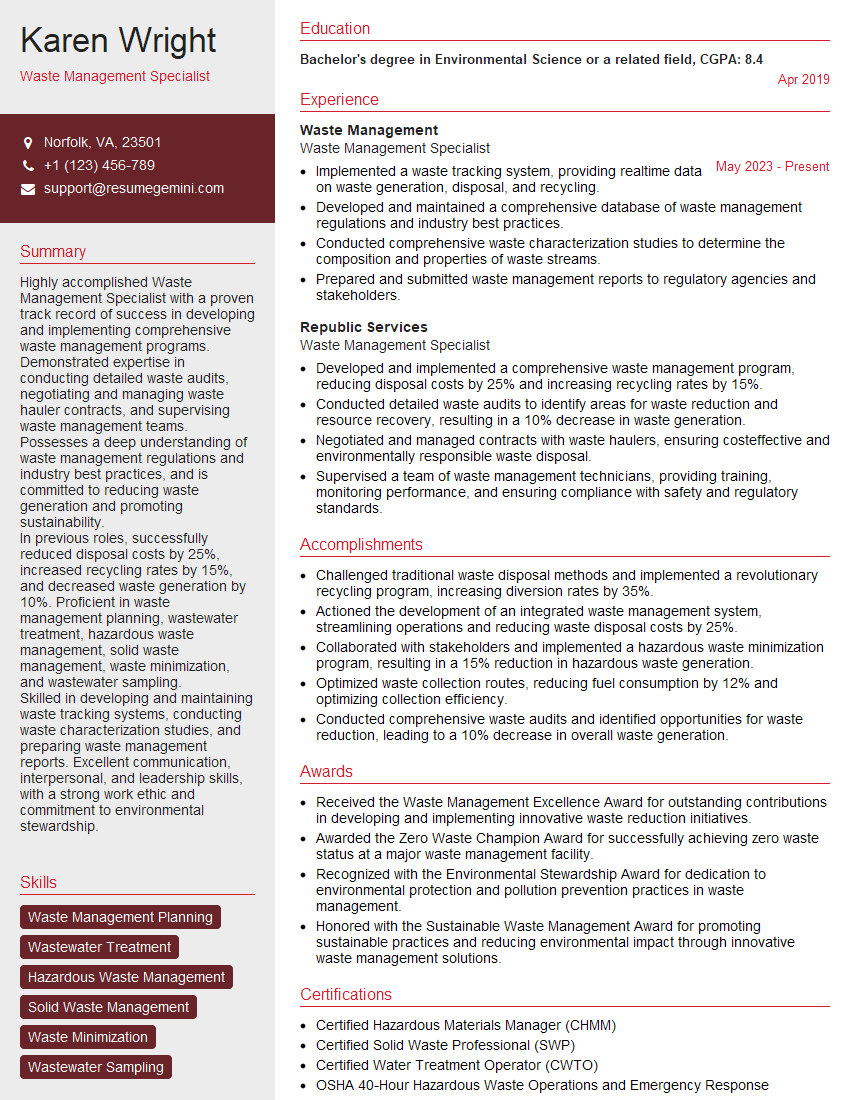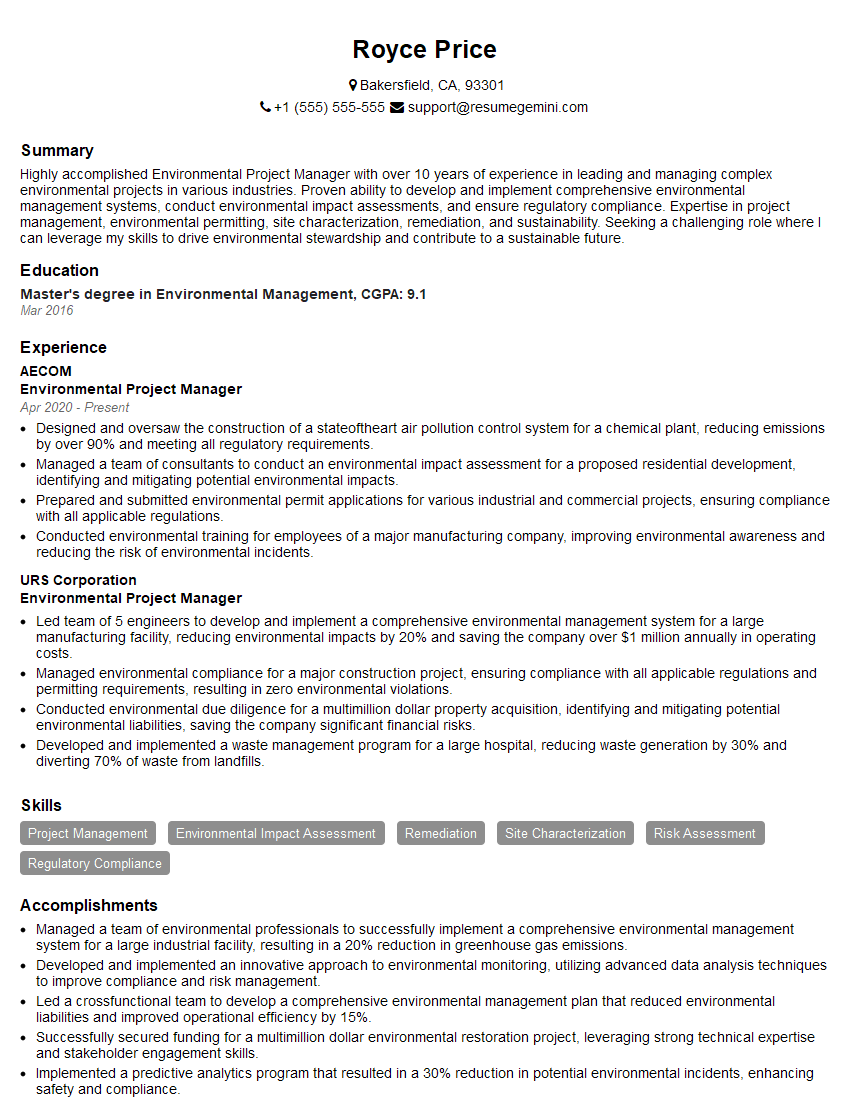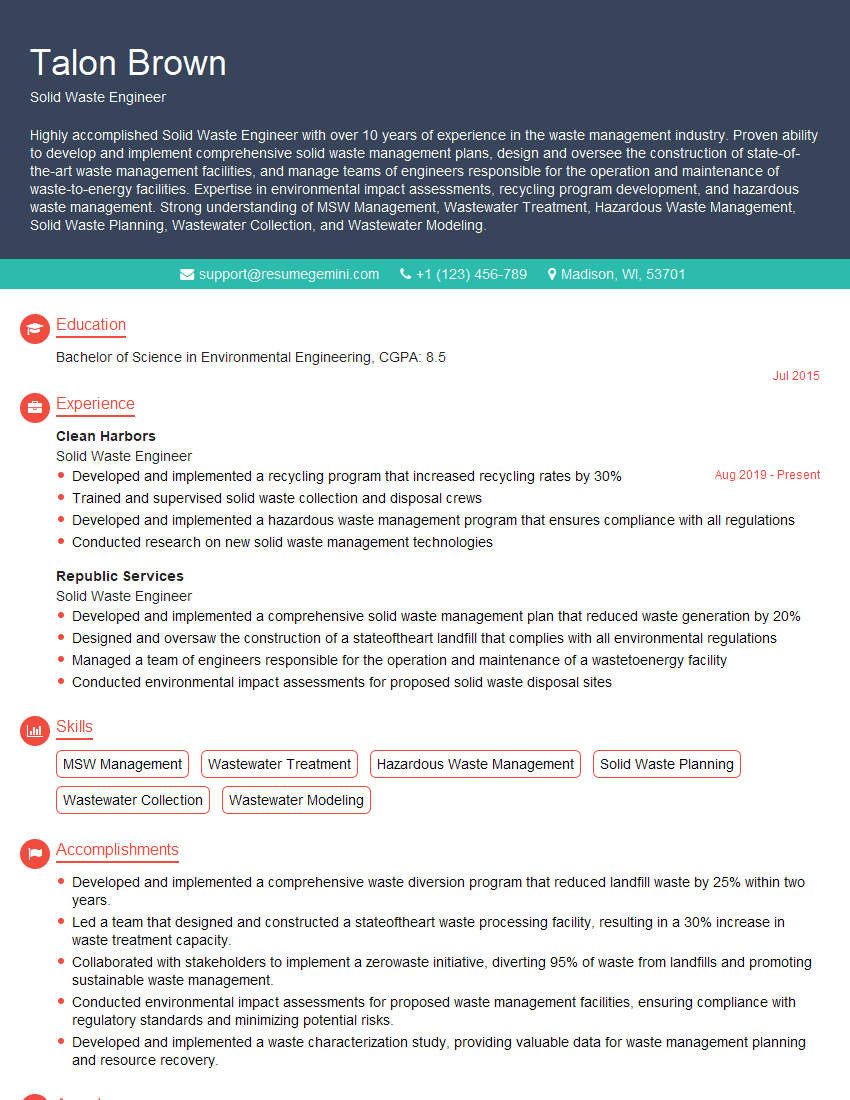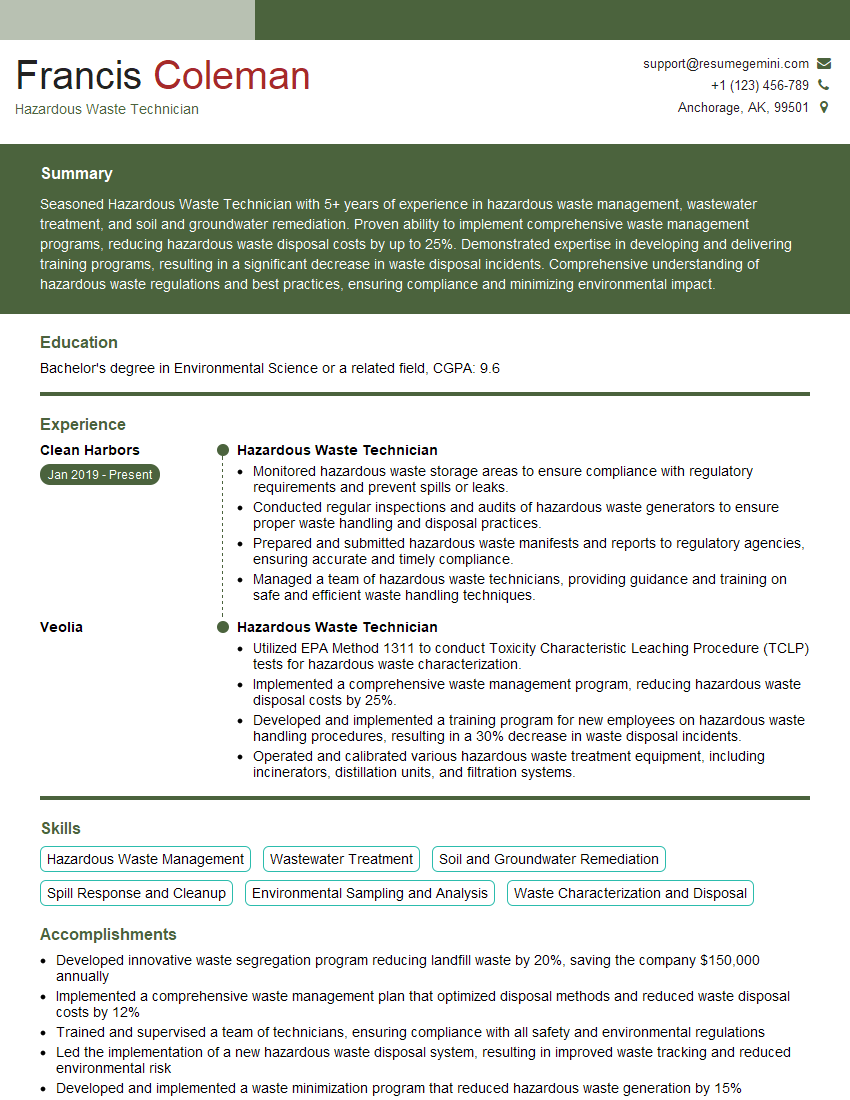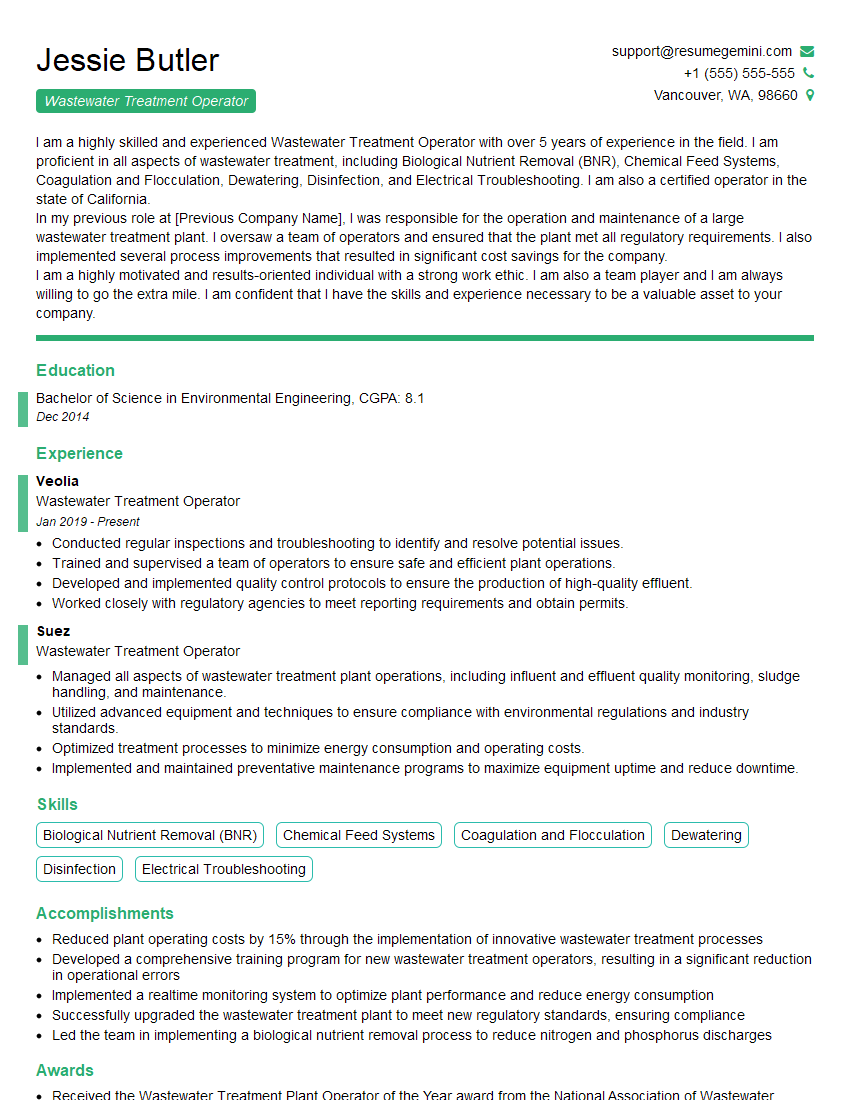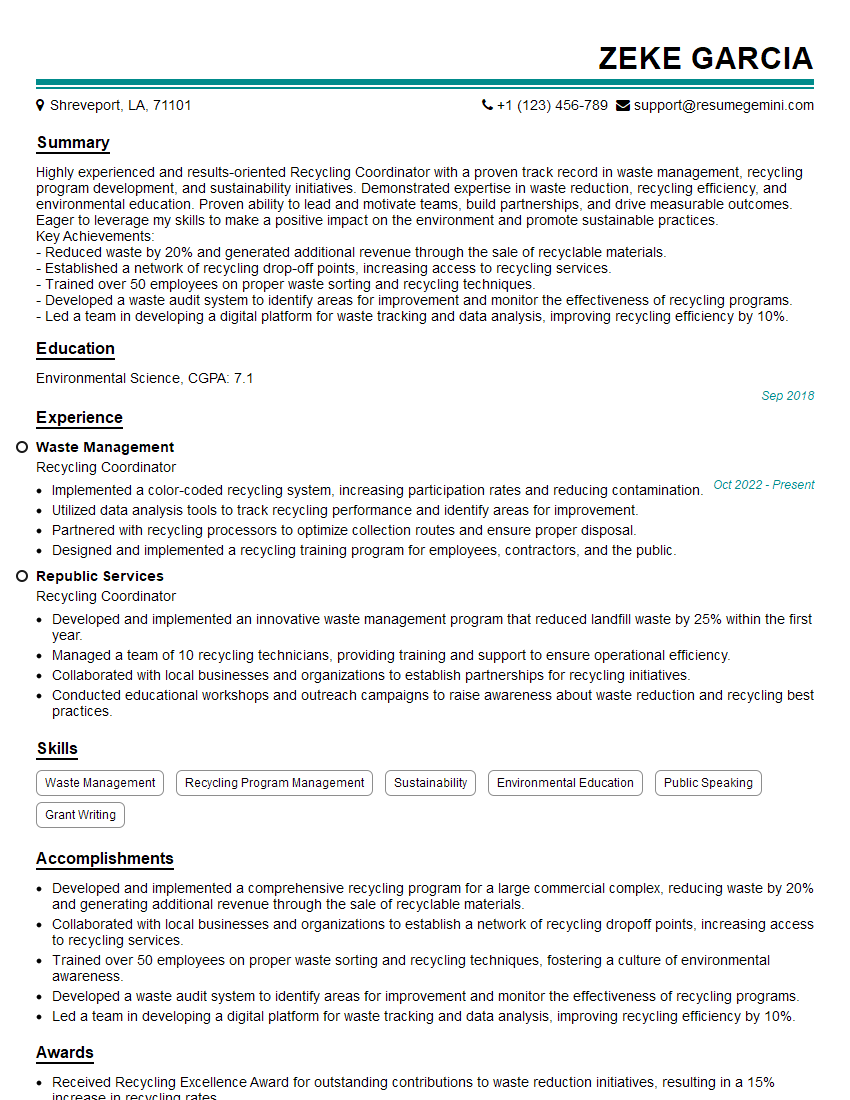Unlock your full potential by mastering the most common Efficient Waste Disposal interview questions. This blog offers a deep dive into the critical topics, ensuring you’re not only prepared to answer but to excel. With these insights, you’ll approach your interview with clarity and confidence.
Questions Asked in Efficient Waste Disposal Interview
Q 1. Explain the hierarchy of waste management.
The waste management hierarchy prioritizes waste prevention and reduction strategies before disposal. Think of it as a pyramid, with the most desirable options at the top and the least desirable at the bottom. The order is generally:
- Prevention: Designing products and processes to minimize waste generation in the first place. This could involve using less packaging, designing for durability and repairability, or shifting to reusable alternatives. For example, a company redesigning its product to use less plastic.
- Reduction: Minimizing the amount of waste generated through source reduction (e.g., using less material) and reuse (e.g., refillable containers). Think of bringing your own reusable shopping bag instead of using a plastic one.
- Recycling: Processing waste materials into new products. This helps conserve resources and reduce landfill burden. Examples are paper, plastic, glass, and metal recycling programs.
- Recovery: Extracting energy or other valuable materials from waste. Incineration with energy recovery is an example of this; composting is another, turning organic waste into valuable soil amendment.
- Disposal: Landfilling or other forms of final waste disposal, such as deep well injection (for hazardous waste), which should be the last resort.
Following this hierarchy ensures efficient and environmentally sound waste management. It maximizes resource recovery and minimizes environmental impact.
Q 2. Describe different waste sorting methods and their effectiveness.
Waste sorting methods are crucial for effective recycling and resource recovery. Several methods exist, each with varying degrees of effectiveness:
- Manual Sorting: Workers manually separate waste streams based on material type. While labor-intensive, it allows for high accuracy, particularly with complex waste streams. This is often used in Materials Recovery Facilities (MRFs).
- Automated Sorting: Machines use technologies like sensors, magnets, and air jets to sort waste automatically. This is faster and more efficient than manual sorting but may have lower accuracy, especially with contaminated materials. Examples include optical sorters identifying plastics by type.
- Source Separation: Households and businesses sort their waste at the point of generation. This requires public education and robust collection systems. Effective source separation increases recycling rates significantly and reduces contamination.
- Combined Sorting Systems: These systems blend automated and manual sorting, combining the strengths of each approach. This often leads to the highest recovery rates.
Effectiveness depends on several factors including the sophistication of the sorting technology, the level of public participation (in source separation), and the quality of waste collection systems. For instance, highly contaminated recycling streams significantly decrease the effectiveness of any sorting method.
Q 3. What are the key environmental regulations concerning waste disposal in your region?
Environmental regulations regarding waste disposal vary by region. However, many jurisdictions share common themes: Regulations often mandate waste minimization, recycling targets, and standards for landfill operations. Specific requirements include:
- Waste Characterization: Businesses often need to characterize their waste streams to determine appropriate management methods. This includes identifying hazardous substances.
- Licensing and Permits: Facilities handling waste, especially hazardous waste, need to obtain proper licenses and permits, demonstrating compliance with safety and environmental standards.
- Landfill regulations: These usually include stringent requirements for liner systems, leachate collection, and gas management to prevent environmental contamination.
- Recycling targets: Many regions set mandatory recycling targets for businesses and municipalities, often focusing on specific materials.
- Hazardous waste management: This area has strict rules covering handling, transport, treatment, and disposal of hazardous substances, often requiring specialized facilities and tracking procedures.
Non-compliance can lead to significant penalties, including fines and legal action. Specific regional regulations should always be consulted for precise requirements. [Note: I cannot provide specific details on your region as it is not specified.]
Q 4. How do you calculate waste diversion rates?
The waste diversion rate measures the percentage of waste diverted from landfills through recycling, composting, and other recovery methods. The formula is:
Waste Diversion Rate = (Total Waste Diverted / Total Waste Generated) x 100%
For example, if a city generated 100,000 tons of waste and diverted 60,000 tons through recycling and composting, the waste diversion rate would be:
Waste Diversion Rate = (60,000 tons / 100,000 tons) x 100% = 60%
Accurate calculation requires reliable data on waste generation and diversion activities. This data is often collected through municipal waste audits and reporting from recycling facilities and composting operations.
Q 5. Discuss the advantages and disadvantages of incineration.
Incineration is a thermal treatment process that reduces waste volume and can generate energy. However, it also has drawbacks:
Advantages:
- Significant volume reduction: Waste volume is reduced by up to 90%, minimizing landfill space needs.
- Energy recovery: Heat from incineration can be used to generate electricity or heat.
- Improved public hygiene: Reduces odors and vermin associated with landfills.
Disadvantages:
- Air pollution: Incineration releases air pollutants, including greenhouse gases and potentially harmful dioxins and furans, although modern facilities employ advanced pollution control technologies to mitigate this.
- Ash management: Incineration produces ash, which may contain hazardous substances and requires careful management and disposal.
- High capital costs: Building and operating incinerators are expensive.
- Public opposition: Concerns about air pollution and potential health impacts often lead to public opposition to incinerator projects.
The decision to use incineration involves a careful cost-benefit analysis, weighing the benefits of volume reduction and energy recovery against the environmental and health concerns.
Q 6. Explain the process of composting organic waste.
Composting is a natural process that decomposes organic waste into a nutrient-rich soil amendment. It involves a controlled environment where microorganisms break down organic matter. The process typically involves these steps:
- Collection and Sorting: Organic materials like food scraps, yard waste, and paper products are collected and separated from other waste streams.
- Shredding (optional): Larger materials may be shredded to increase surface area for faster decomposition.
- Mixing: Organic materials are mixed to create a homogenous pile with optimal moisture and air content. The ideal carbon-to-nitrogen ratio is crucial for efficient decomposition.
- Turning (aeration): Regularly turning the compost pile introduces oxygen to support aerobic decomposition (decomposition requiring oxygen). This prevents anaerobic decomposition, which produces foul odors and methane.
- Monitoring temperature and moisture: Maintaining the optimal temperature and moisture level is essential for proper decomposition. A temperature spike indicates active decomposition.
- Curing: After the active decomposition phase, the compost is allowed to cure for several weeks or months to stabilize.
- Screening (optional): Mature compost may be screened to remove any remaining large particles.
Composting offers a sustainable way to manage organic waste, reducing landfill burden and creating valuable soil amendment. Effective composting requires careful management of moisture, temperature, and aeration.
Q 7. What are the challenges in managing hazardous waste?
Managing hazardous waste presents unique challenges due to its potential to harm human health and the environment. Key challenges include:
- Identification and Characterization: Accurate identification and characterization of hazardous waste is crucial for selecting appropriate management methods. This often requires specialized laboratory testing.
- Treatment and Disposal: Hazardous waste often requires specialized treatment processes before disposal to reduce its toxicity and prevent environmental contamination. Options include incineration, chemical stabilization, and secure landfilling.
- Transportation and Storage: Transporting and storing hazardous waste requires strict adherence to safety regulations to prevent spills or leaks. Specialized containers and transport vehicles are required.
- Regulatory Compliance: Hazardous waste management is heavily regulated, requiring detailed record-keeping, permit applications, and compliance with stringent environmental standards. Penalties for non-compliance are severe.
- Public perception and acceptance: Siting hazardous waste treatment and disposal facilities often encounters public opposition due to concerns about potential risks.
- Cost: Managing hazardous waste is expensive, from characterization and treatment to transportation and disposal. This often necessitates stringent cost-benefit analyses.
Effective hazardous waste management necessitates a multi-faceted approach involving careful planning, stringent regulations, advanced treatment technologies, and public engagement.
Q 8. How do you assess the effectiveness of a waste reduction program?
Assessing the effectiveness of a waste reduction program requires a multifaceted approach, going beyond simply measuring the amount of waste diverted from landfills. We need to consider several key factors.
- Waste Diversion Rate: This is a fundamental metric, calculating the percentage of waste diverted from landfills through recycling, composting, or other waste reduction strategies. A higher percentage indicates greater success.
- Waste Characterization: Understanding the composition of the waste stream is crucial. This helps identify areas for improvement, such as promoting recycling of specific materials that are currently ending up in landfills.
- Community Engagement: A successful program needs active participation from the community. We assess this through surveys, participation rates in educational programs, and feedback mechanisms.
- Cost-Effectiveness: We analyze the program’s costs against its environmental and economic benefits. Is the program efficiently achieving its goals without excessive expenditure?
- Environmental Impact Assessment: We consider the broader environmental effects, such as reduced greenhouse gas emissions from landfills, decreased pollution from manufacturing new products from recycled materials, and conservation of natural resources.
For example, a program aiming to reduce plastic waste might track the reduction in plastic bag usage, the increase in plastic bottle recycling rates, and the overall reduction in plastic waste sent to landfills. Regular monitoring and adjustments based on data analysis are crucial for program optimization.
Q 9. Describe different types of landfills and their environmental impacts.
Landfills vary significantly in their design and environmental impact. Here are some key types:
- Sanitary Landfills: These are the most common type, employing engineered methods to minimize environmental harm. Waste is compacted and covered with soil daily to reduce odor and leachate (liquid that percolates through waste). They often include systems for collecting and treating leachate, and methane gas, a potent greenhouse gas, is usually captured and used for energy generation or flared off. However, even sanitary landfills contribute to greenhouse gas emissions and can contaminate groundwater if not managed properly.
- Secure Landfills: Designed to handle hazardous waste, these landfills have multiple layers of protection, including liners and leachate collection systems, to prevent contamination of soil and groundwater. They are subject to strict regulatory oversight and monitoring.
- Municipal Solid Waste (MSW) Landfills: These handle everyday household and commercial waste. Their environmental impact depends heavily on their design, management, and location. Improperly managed MSW landfills are significant sources of pollution and greenhouse gases.
The environmental impacts of landfills include:
- Greenhouse Gas Emissions: Decomposing organic matter in landfills produces methane, a potent greenhouse gas.
- Leachate Contamination: Leachate can contaminate groundwater and surface water sources, posing risks to human health and ecosystems.
- Air Pollution: Landfills can release various air pollutants, including odors and volatile organic compounds.
- Land Use: Landfills consume significant land area, reducing the availability of land for other purposes.
Choosing appropriate landfill technologies and stringent regulatory compliance are crucial for minimizing their environmental footprint.
Q 10. What are the best practices for e-waste recycling?
E-waste recycling is critical due to the hazardous materials found in electronic devices. Best practices include:
- Responsible Disposal: Never throw e-waste in the trash. Use designated e-waste collection points or certified recyclers.
- Data Security: Ensure data is securely erased from devices before recycling to prevent identity theft.
- Manufacturer Take-Back Programs: Many manufacturers offer take-back programs for their products. This promotes responsible recycling and reduces the environmental impact.
- Certified Recyclers: Choose recyclers certified by organizations like e-Stewards or R2, which ensure adherence to strict environmental and social standards.
- Material Recovery: Prioritize recyclers who focus on material recovery (separating valuable materials like gold, copper, and plastics for reuse), rather than simple disposal or landfilling.
- Repair and Reuse: Before disposing, consider repairing or donating functioning electronics to extend their lifespan and reduce the demand for new products.
For example, a responsible e-waste recycling program will ensure that hazardous materials like mercury and lead are safely extracted and managed, minimizing their potential harm to the environment and human health. Transparency and traceability in the recycling process are paramount.
Q 11. How do you minimize the environmental impact of waste transportation?
Minimizing the environmental impact of waste transportation involves optimizing routes and using fuel-efficient vehicles. This includes:
- Route Optimization: Using software to plan the most efficient collection routes minimizes fuel consumption and reduces vehicle emissions.
- Fuel-Efficient Vehicles: Using hybrid or electric vehicles, and optimizing vehicle maintenance to maximize fuel efficiency significantly reduces the carbon footprint of transportation.
- Waste Consolidation: Consolidating waste at transfer stations before transportation to larger processing facilities reduces the number of trips needed and thus the associated emissions.
- Modal Shift: Where feasible, shifting from road transport to rail or water transport can dramatically reduce emissions, especially for long distances.
- Vehicle Maintenance: Regularly maintaining vehicles ensures optimal fuel efficiency and reduces emissions.
Imagine a city implementing a system where waste is collected using electric vehicles along optimized routes, significantly lowering its overall transportation-related environmental impact.
Q 12. Explain the concept of life-cycle assessment in waste management.
Life-cycle assessment (LCA) in waste management is a comprehensive analysis of the environmental impacts of a product or process, from its creation to its disposal. It considers:
- Raw Material Extraction: The environmental impacts associated with obtaining the raw materials needed to manufacture the product.
- Manufacturing: The energy consumption, emissions, and waste generated during the manufacturing process.
- Use Phase: The environmental impacts during the product’s use, such as energy consumption and emissions.
- End-of-Life Management: The impacts associated with recycling, composting, incineration, or landfilling of the product.
By considering the entire life cycle, LCA helps identify opportunities for improvement at each stage. For example, an LCA of a plastic water bottle might reveal that the manufacturing process is highly energy-intensive, while the end-of-life disposal contributes to landfill waste. This information guides the design of more sustainable products and processes.
Q 13. What are the key performance indicators (KPIs) for a waste management facility?
Key performance indicators (KPIs) for a waste management facility are crucial for monitoring performance and identifying areas for improvement. These include:
- Waste Diversion Rate: The percentage of waste diverted from landfills through recycling, composting, or other methods.
- Recycling Rate: The percentage of recyclable materials actually recycled.
- Landfill Gas Capture Rate: The percentage of landfill gas captured and used for energy generation.
- Leachate Generation Rate: The amount of leachate generated per ton of waste received.
- Processing Capacity: The volume of waste processed per day or year.
- Operational Efficiency: Metrics related to minimizing operating costs and maximizing resource utilization.
- Safety Incidents: The number and severity of safety incidents at the facility.
- Environmental Compliance: Adherence to all environmental regulations and permits.
Tracking these KPIs allows for continuous improvement and ensures the facility operates efficiently and sustainably.
Q 14. How do you manage and mitigate risks associated with landfill operations?
Managing and mitigating risks associated with landfill operations requires a proactive and comprehensive approach.
- Site Selection: Careful site selection is crucial to minimize risks to groundwater and surrounding ecosystems. Geological surveys and hydrological assessments are essential.
- Leachate Management: Implementing robust leachate collection and treatment systems is paramount to prevent groundwater contamination. Regular monitoring of leachate quality is necessary.
- Gas Management: Effective landfill gas collection and management systems are necessary to control methane emissions and potentially utilize the gas as an energy source. Regular monitoring of gas concentrations is crucial.
- Erosion and Runoff Control: Implementing measures to control erosion and runoff prevents contamination of surface waters.
- Emergency Response Plans: Develop and regularly test emergency response plans to address potential incidents, such as fires or leaks.
- Monitoring and Reporting: Regular monitoring of environmental parameters and reporting to regulatory agencies are essential for compliance and risk management.
- Closure and Post-Closure Care: Planning for landfill closure and long-term post-closure care is crucial to minimize long-term environmental impacts.
A proactive risk management program, combining engineering controls, environmental monitoring, and emergency response planning, is essential for ensuring safe and responsible landfill operations.
Q 15. Discuss the role of technology in improving waste management efficiency.
Technology plays a crucial role in boosting waste management efficiency. It allows for better tracking, optimized collection routes, improved sorting processes, and data-driven decision-making. Think of it as giving waste management a powerful brain and nimble hands.
- Smart bins: These sensors monitor fill levels, alerting collection crews when bins need emptying, optimizing routes and reducing fuel consumption. Imagine a city where garbage trucks only visit when necessary, reducing traffic and noise pollution.
- Waste sorting AI: Artificial intelligence can analyze waste streams, identifying and sorting materials with greater accuracy than manual processes. This improves recycling rates and reduces contamination.
- GPS tracking and route optimization software: Tracking waste collection vehicles in real-time optimizes routes, minimizes fuel usage, and improves overall efficiency. This is like using a sophisticated navigation system for garbage trucks.
- Data analytics dashboards: These provide real-time insights into waste generation, composition, and collection performance, enabling informed decisions about resource allocation and program improvement. This allows us to pinpoint problem areas and address them proactively.
In essence, technology transforms waste management from a reactive, labor-intensive process into a proactive, data-driven system that is both more efficient and environmentally friendly.
Career Expert Tips:
- Ace those interviews! Prepare effectively by reviewing the Top 50 Most Common Interview Questions on ResumeGemini.
- Navigate your job search with confidence! Explore a wide range of Career Tips on ResumeGemini. Learn about common challenges and recommendations to overcome them.
- Craft the perfect resume! Master the Art of Resume Writing with ResumeGemini’s guide. Showcase your unique qualifications and achievements effectively.
- Don’t miss out on holiday savings! Build your dream resume with ResumeGemini’s ATS optimized templates.
Q 16. How do you develop and implement a comprehensive waste management plan?
Developing and implementing a comprehensive waste management plan requires a systematic approach. It’s like building a house; you need a strong foundation and careful planning to ensure a robust and effective system.
- Assessment and Characterization: Begin by conducting a thorough waste audit to understand the types and quantities of waste generated, their sources, and current disposal methods. This is our blueprint.
- Goal Setting: Establish clear, measurable, achievable, relevant, and time-bound (SMART) goals for waste reduction, recycling, and disposal. For instance, aiming to reduce landfill waste by 20% within five years.
- Strategy Development: Develop strategies to achieve these goals, incorporating methods like source reduction, recycling programs, composting, and anaerobic digestion. This is where we choose our materials and building techniques.
- Infrastructure Development: This involves securing necessary resources, including collection vehicles, processing facilities, and disposal sites. It’s like acquiring the building materials and tools.
- Stakeholder Engagement: Collaborate closely with community members, businesses, and government agencies to ensure buy-in and support for the plan. Getting everyone on board is vital.
- Implementation and Monitoring: Put the plan into action, regularly monitoring its effectiveness and making adjustments as needed. This is like the ongoing maintenance and improvements needed for any building.
- Evaluation and Reporting: Track progress towards goals, document successes and challenges, and prepare regular reports to communicate progress to stakeholders. This ensures accountability and transparency.
This structured approach guarantees a well-defined, effective, and adaptable waste management system tailored to the specific needs of the community.
Q 17. Describe your experience with waste audits and their significance.
Waste audits are crucial for understanding the composition and characteristics of waste streams. They provide the foundation for designing effective waste management strategies. It’s like conducting a physical exam for a city’s waste ‘patient’.
My experience involves conducting various waste audits, ranging from small residential complexes to large industrial facilities. These audits typically involve:
- Sampling and weighing waste: Collecting representative samples of waste to determine the composition (e.g., percentage of recyclables, organics, hazardous waste).
- Data analysis: Analyzing the data to identify trends, strengths, and weaknesses in current waste management practices. For instance, a high percentage of recyclable materials improperly disposed of might highlight a need for improved public education campaigns.
- Reporting and recommendations: Preparing reports summarizing the findings and suggesting tailored recommendations to improve waste management efficiency and reduce environmental impact. For example, recommending improvements to sorting infrastructure or public awareness campaigns.
The significance of waste audits cannot be overstated. They provide the essential data-driven insights needed to develop targeted, cost-effective, and environmentally responsible waste management solutions.
Q 18. What are the strategies for promoting recycling and waste reduction within a community?
Promoting recycling and waste reduction within a community requires a multi-pronged approach, combining education, incentives, and infrastructure improvements. It’s about fostering a culture of responsible waste management.
- Public awareness campaigns: Educate residents about the benefits of recycling and waste reduction through informative materials, workshops, and community events. This could include using social media campaigns or creating fun interactive quizzes.
- Convenient recycling infrastructure: Provide easily accessible recycling bins in public spaces and offer curbside recycling programs. A lack of convenient options can quickly deter people from participating.
- Financial incentives: Implement pay-as-you-throw (PAYT) programs that charge residents based on the amount of waste they generate, incentivizing waste reduction. This can create a strong personal motivation for change.
- Composting programs: Offer community composting programs or provide residents with home composting bins to manage organic waste. Composting is a fantastic way to manage organic waste and produce beneficial soil amendment.
- Extended Producer Responsibility (EPR): Involve producers in the responsibility for managing end-of-life products, encouraging them to design more recyclable products. Holding producers accountable for the lifecycle of their products helps drive sustainable design choices.
- Partnerships and collaboration: Collaborate with local businesses, schools, and community organizations to promote recycling and waste reduction initiatives. Community engagement is key for creating a collective approach to waste management.
A combination of these strategies can effectively cultivate a community-wide commitment to responsible waste management.
Q 19. Explain the differences between anaerobic and aerobic digestion.
Both anaerobic and aerobic digestion are biological processes that break down organic matter, but they differ significantly in their oxygen requirements and byproducts.
Aerobic digestion uses oxygen to decompose organic waste. Think of it like a compost heap – microorganisms thrive in the presence of oxygen, breaking down the organic matter and producing carbon dioxide, water, and heat. It’s relatively fast and produces a stable compost that can be used as a soil amendment.
Anaerobic digestion, on the other hand, occurs in the absence of oxygen. Microorganisms break down the organic matter, producing biogas (a mixture of methane and carbon dioxide) and digestate (a nutrient-rich material). Anaerobic digestion is slower but yields biogas, a valuable renewable energy source. The digestate can be used as a fertilizer.
Here’s a table summarizing the key differences:
| Feature | Aerobic Digestion | Anaerobic Digestion |
|---|---|---|
| Oxygen Requirement | Requires oxygen | No oxygen required |
| Process Speed | Faster | Slower |
| Byproducts | Compost, CO2, water, heat | Biogas (methane, CO2), digestate |
| Energy Production | Low | High (biogas) |
The choice between aerobic and anaerobic digestion depends on factors such as the type of waste, desired byproducts, and available infrastructure.
Q 20. How do you handle conflicts with stakeholders regarding waste management practices?
Handling conflicts with stakeholders is an inevitable aspect of waste management. Open communication and collaborative problem-solving are crucial for navigating these situations. It’s about finding win-win solutions.
- Active Listening: Begin by actively listening to all stakeholders’ concerns and perspectives. Understanding their viewpoints is the first step towards finding common ground.
- Identify Common Goals: Focus on shared objectives, such as a cleaner environment or a more sustainable community. Highlighting these shared goals can help bridge differences.
- Facilitate Dialogue: Create a platform for open and respectful dialogue where stakeholders can express their opinions and concerns without interruption.
- Compromise and Negotiation: Be prepared to compromise and negotiate to find mutually acceptable solutions. This might involve adjusting implementation plans or offering alternative solutions.
- Transparency and Communication: Maintain transparency throughout the process, regularly communicating progress and decisions to all stakeholders. Keeping everyone informed helps prevent misunderstandings and builds trust.
- Mediation or Arbitration: If necessary, involve a neutral third party to mediate discussions or arbitrate disagreements. Sometimes an outside perspective can be invaluable.
Effective conflict resolution requires patience, empathy, and a commitment to finding solutions that satisfy all stakeholders. This strengthens the overall success of the waste management initiative.
Q 21. Describe your experience with waste-to-energy technologies.
Waste-to-energy (WtE) technologies convert non-recyclable waste into usable energy, offering a sustainable solution for waste disposal. It’s like turning trash into treasure.
My experience includes working with various WtE technologies, primarily focusing on:
- Incineration with energy recovery: This involves burning waste at high temperatures to generate heat, which is then used to produce electricity or steam. It’s a well-established technology, but concerns about air emissions must be addressed through robust pollution control systems.
- Gasification: This process converts waste into a syngas (synthetic gas) that can be used to generate electricity or produce other fuels. Gasification offers a higher energy recovery efficiency compared to incineration, and it can handle a wider range of waste materials.
- Anaerobic digestion: As mentioned earlier, this process generates biogas, which is a renewable energy source that can be used for electricity generation or heat production.
The effectiveness of WtE technologies depends on factors such as the type of waste, available technology, environmental regulations, and economic considerations. Careful planning and rigorous environmental monitoring are essential for ensuring these technologies are implemented sustainably and responsibly.
Q 22. What are the best practices for handling medical waste?
Handling medical waste requires stringent protocols to prevent the spread of infectious diseases and protect the environment. It begins with segregation at the source – separating different types of medical waste (e.g., sharps, infectious waste, pharmaceutical waste) into designated color-coded containers. This prevents cross-contamination and simplifies downstream processing.
Next, proper packaging and labeling are crucial. Each container must be clearly labeled with its contents and any biohazards. Sharps containers, for example, are designed to prevent punctures and leakage. Infectious waste requires double bagging and leak-proof containers.
Transportation must follow specific regulations, using designated vehicles and trained personnel. These vehicles are often equipped with GPS tracking and specialized safety features. Finally, treatment and disposal must be handled by licensed facilities employing methods like incineration, autoclaving, or chemical disinfection, depending on the waste type and local regulations. Proper record-keeping throughout the entire process is essential for compliance and accountability.
For instance, in a hospital setting, I’ve implemented a color-coded system with comprehensive training for all staff, resulting in a significant reduction in accidental needle-stick injuries and improved compliance with waste handling protocols.
Q 23. How do you ensure compliance with environmental regulations concerning waste disposal?
Ensuring compliance with environmental regulations is paramount in waste management. This involves a multi-faceted approach beginning with a thorough understanding of all applicable local, regional, and national laws and regulations. This often includes permits, licenses, and reporting requirements.
We establish a comprehensive compliance program including regular internal audits to ensure we meet all regulatory requirements. This involves reviewing waste streams, documenting procedures, training staff, and ensuring accurate record-keeping. We also utilize specialized software to track waste generation, disposal methods, and associated costs, helping us monitor our performance against regulatory limits and identify areas for improvement.
Regular interaction with regulatory agencies is key. This involves attending industry conferences, proactively seeking clarification on ambiguous regulations, and promptly addressing any identified deficiencies. Proactive communication reduces the risk of penalties and ensures we maintain a strong relationship with regulatory bodies. For example, we’ve successfully implemented a new waste reduction initiative after consulting with the EPA, resulting in reduced landfill burden and significant cost savings.
Q 24. Explain your understanding of the circular economy principles.
The circular economy aims to minimize waste and maximize resource utilization by keeping materials in use for as long as possible. It’s a departure from the traditional linear ‘take-make-dispose’ model, focusing instead on a cyclical approach.
- Reduce: Minimizing waste generation at the source through design, process optimization, and consumer behavior changes. For example, designing products for durability and repairability.
- Reuse: Extending the lifespan of materials through repurposing, repairing, and remanufacturing. Think of refillable containers or upcycled clothing.
- Recycle: Processing materials to recover valuable resources and create new products. This involves efficient collection, sorting, and processing systems.
- Recover: Extracting energy from waste through processes like incineration with energy recovery or anaerobic digestion.
- Dispose: Only as a last resort, employing responsible and environmentally sound methods.
In my experience, implementing circular economy principles has led to significant cost reductions through material recovery and reduced landfill fees. Furthermore, it enhances a company’s sustainability profile and aligns with growing consumer demand for eco-friendly practices.
Q 25. Describe your experience with data analysis and reporting in waste management.
Data analysis and reporting are vital for effective waste management. I’ve extensively used data analytics tools and techniques to track key performance indicators (KPIs) like waste generation rates, recycling percentages, and disposal costs. This involves collecting data from various sources, including weigh scales, waste manifests, and electronic monitoring systems.
I use statistical software (R, Python) and data visualization tools (Tableau, Power BI) to analyze this data, identifying trends, patterns, and areas for improvement. This allows for evidence-based decision-making regarding waste reduction strategies and resource allocation. For example, using statistical modeling, I identified that a specific packaging change in our manufacturing process could lead to a 15% reduction in waste generation.
Clear and concise reporting is crucial for communicating findings to stakeholders, including management, regulatory agencies, and the public. This involves creating customized reports with relevant charts and graphs, highlighting key achievements and areas requiring attention. Effective data-driven reporting ensures accountability and transparency, demonstrating the effectiveness of our waste management programs.
Q 26. How do you stay current with the latest developments and technologies in waste management?
Staying current in the dynamic field of waste management is essential. I regularly read industry publications, attend conferences and workshops, and participate in professional organizations like the Waste Management & Research Center (WMRC).
I actively network with colleagues and experts in the field, sharing best practices and learning about new technologies and approaches. I also engage in online learning platforms, taking courses on topics such as advanced recycling techniques and sustainable waste management practices. This continuous learning ensures I’m equipped with the latest knowledge and skills to address evolving challenges in the industry.
For example, I recently completed a course on AI-powered waste sorting technology, which has opened new possibilities for improving our recycling efficiency and reducing contamination.
Q 27. What are your strategies for improving employee safety in a waste management setting?
Employee safety is my top priority. This starts with comprehensive safety training for all personnel, covering topics such as proper handling techniques for different waste streams, use of personal protective equipment (PPE), emergency procedures, and hazard communication. Regular refresher training reinforces safe practices.
We implement a robust safety management system, including regular safety inspections, incident reporting and investigation procedures, and proactive hazard identification and risk assessment. This involves identifying potential hazards and implementing controls to mitigate risks. We also foster a strong safety culture where employees feel empowered to report hazards and concerns without fear of retribution.
Furthermore, we utilize ergonomic principles in the design of our workplaces and equipment to minimize the risk of musculoskeletal injuries. For instance, we’ve invested in automated equipment for handling heavy waste containers, reducing the physical strain on our employees. Continuous monitoring and improvements in our safety program based on data analysis helps ensure a safe working environment.
Q 28. Describe your experience in budgeting and resource allocation for waste management projects.
Budgeting and resource allocation for waste management projects requires a strategic approach. This involves understanding the full cost of waste management, including collection, processing, disposal, and compliance costs. I develop detailed budgets, forecasting costs based on historical data, projected waste volumes, and anticipated changes in regulations or technology.
Resource allocation decisions are made based on a prioritized list of projects and their potential return on investment (ROI). This involves evaluating the environmental and economic benefits of different projects, considering factors such as waste reduction targets, cost savings, and compliance requirements. We utilize cost-benefit analysis and other financial modeling techniques to make informed decisions.
For example, I’ve successfully secured funding for a new composting facility by demonstrating its environmental and financial benefits, including reduced landfill costs and potential revenue generation from compost sales. Effective budgeting and resource allocation ensure projects are completed efficiently and effectively, maximizing the impact of available resources.
Key Topics to Learn for Efficient Waste Disposal Interview
- Waste Stream Analysis: Understanding the composition of different waste streams (residential, commercial, industrial) and their impact on the environment. This includes practical application in identifying opportunities for waste reduction and diversion.
- Waste Reduction Strategies: Exploring methods for minimizing waste generation at the source, such as implementing source reduction programs, promoting reuse and repurposing initiatives, and designing for durability and recyclability. Consider real-world examples of successful implementation.
- Recycling and Composting Processes: Gaining a thorough understanding of the different types of recycling (e.g., curbside, single-stream, materials recovery facilities) and composting methods, including their efficiencies and limitations. Analyze the challenges and innovations in these areas.
- Waste Collection and Transportation: Familiarize yourself with the logistics of waste collection, including route optimization, fleet management, and the environmental impact of transportation. Consider the role of technology in improving efficiency.
- Waste Treatment and Disposal Technologies: Explore various waste treatment options, such as incineration, landfilling, anaerobic digestion, and their associated environmental impacts and regulatory compliance requirements. Be prepared to discuss the pros and cons of each.
- Waste Management Regulations and Compliance: Understand relevant local, regional, and national regulations governing waste disposal, including permits, reporting requirements, and environmental protection standards. Consider the implications of non-compliance.
- Life Cycle Assessment (LCA) of Waste Management Systems: Develop an understanding of how to conduct a life cycle assessment to evaluate the environmental impacts of different waste management strategies throughout their entire lifecycle.
- Sustainable Waste Management Practices: Explore innovative and sustainable approaches to waste management, such as circular economy models, zero-waste initiatives, and the integration of renewable energy technologies into waste treatment facilities.
Next Steps
Mastering efficient waste disposal principles is crucial for a successful career in this growing field. Demonstrating a comprehensive understanding of these concepts will significantly enhance your job prospects. To make your application stand out, create an ATS-friendly resume that effectively highlights your skills and experience. ResumeGemini is a trusted resource that can help you build a professional and impactful resume. Examples of resumes tailored to the Efficient Waste Disposal industry are available to further guide your preparation.
Explore more articles
Users Rating of Our Blogs
Share Your Experience
We value your feedback! Please rate our content and share your thoughts (optional).

